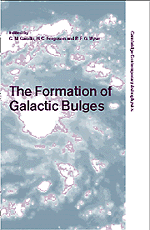Book contents
- Frontmatter
- Contents
- Preface
- Dedication: In Memory of Olin Eggen
- Part 1 Introduction
- Part 2 The Epoch of Bulge Formation
- Part 3 The Timescales of Bulge Formation
- Part 4 Physical Processes in Bulge Formation
- The Role of Bars for Secular Bulge Formation
- Bars and Boxy/Peanut-Shaped Bulges: An Observational Point of View
- Boxy- and Peanut-Shaped Bulges
- A New Class of Bulges
- The Role of Secondary Bars in Bulge Formation
- Radial Transport of Molecular Gas to the Nuclei of Spiral Galaxies
- Dynamical Evolution of Bulge Shapes
- Two-Component Stellar Systems: Phase-Space Constraints
- Central NGC 2146 – A Firehose-Type Bending Instability?
- Bulge Formation: The Role of the Multi-Phase ISM
- Global Evolution of a Self-Gravitating Multi-Phase ISM in the Central Kpc Region of Galaxies
- Part 5 Bulge Phenomenology
- Part 6 Conference Summary
- Index
Dynamical Evolution of Bulge Shapes
from Part 4 - Physical Processes in Bulge Formation
Published online by Cambridge University Press: 10 November 2010
- Frontmatter
- Contents
- Preface
- Dedication: In Memory of Olin Eggen
- Part 1 Introduction
- Part 2 The Epoch of Bulge Formation
- Part 3 The Timescales of Bulge Formation
- Part 4 Physical Processes in Bulge Formation
- The Role of Bars for Secular Bulge Formation
- Bars and Boxy/Peanut-Shaped Bulges: An Observational Point of View
- Boxy- and Peanut-Shaped Bulges
- A New Class of Bulges
- The Role of Secondary Bars in Bulge Formation
- Radial Transport of Molecular Gas to the Nuclei of Spiral Galaxies
- Dynamical Evolution of Bulge Shapes
- Two-Component Stellar Systems: Phase-Space Constraints
- Central NGC 2146 – A Firehose-Type Bending Instability?
- Bulge Formation: The Role of the Multi-Phase ISM
- Global Evolution of a Self-Gravitating Multi-Phase ISM in the Central Kpc Region of Galaxies
- Part 5 Bulge Phenomenology
- Part 6 Conference Summary
- Index
Summary
Figure rotation substantially increases the fraction of stochastic orbits in triaxial systems. This increase is most dramatic in systems with shallow cusps showing that it is not a direct consequence of scattering by a central density cusp or black hole. In a recent study of stationary triaxial potentials (Valluri & Merritt 1998) it was found that the most important elements that define the structure of phase space are the two-dimensional resonant tori. The increase in the fraction of stochastic orbits in models with figure rotation is a direct consequence of the destabilization of these resonant tori.
The presence of a large fraction of stochastic orbits in a triaxial bulge will result in the evolution of its shape from triaxial to axisymmetric. The timescales for evolution can be as short as a few crossing times in the bulges of galaxies and evolution is accelerated by figure rotation. This suggests that low luminosity ellipticals and the bulges of early type spirals are likely to be predominantly axisymmetric.
Introduction
It is now widely believed that the effects of central black holes and cusps on the dynamics of triaxial galaxies are well understood: the box orbits which form the back bone of triaxial elliptical galaxies become chaotic due to scattering by the divergent central force (e.g. Gerhard & Binney 1985). The scattering of these orbits then results in the evolution of the triaxial galaxy to an axisymmetric one whose dynamics is dominated by well behaved families of regular orbits.
- Type
- Chapter
- Information
- The Formation of Galactic Bulges , pp. 136 - 139Publisher: Cambridge University PressPrint publication year: 2000

